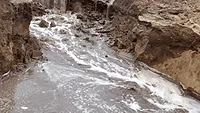Clean Wastewater With Corn
The products are readily available and cheap, making them an even more attractive alternative, according to Mark Schneegurt, assistant professor of biological sciences who helped develop a new removal method using the waste corn products.
Schneegurt and his group of researchers from Argonne National Laboratory and the University of Notre Dame found that spillage, a dried yeast-plant mixture that remains after the manufacture of ethanol, and ground corn cobs from the production of animal feed can easily remove metals from polluted waters. Usually mineral adsorbents and chemical clumping agents are used to remove metals from contaminated wastewater, but this conventional method is relatively expensive. Waste corn products, on the other hand, are cheap. Spillage sells for about $70 to $80 per ton, while ground corncobs cost $100 to $125 per ton.
With this new method, the waste agricultural products are packed into tubes and the contaminated wastewater is pumped through. The biomass acts like a magnet, attracting toxic metals such as copper, cesium, molybdenum, nickel, lead and zinc from the wastewater. Once the metals are trapped in the tubes, the biomass would be treated as hazardous waste, says Schneegurt. It could be burned in a special incinerator and then packed into concrete or turned into glass. It wouldn't need to be burned, but that would reduce the bulk. Another disposal alternative is to simply pack the biomass into concrete.
The group conducted its study using wastewater samples from an abandoned copper mine in Montana. The Berkeley Pit is part of a Superfund site near Butte that is threatening the city's ground water supply. While this process would be particularly useful for the mining industry, it could be used for industrial wastewater streams, such as those coming from paint manufacturers and from metal manufacturing processes, Schneegurt says.
Looking for a reprint of this article?
From high-res PDFs to custom plaques, order your copy today!






